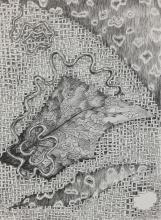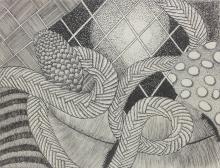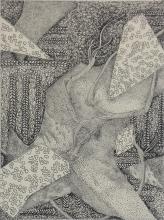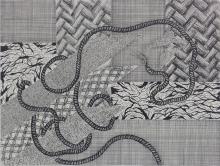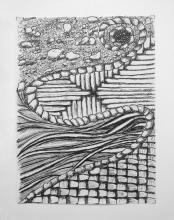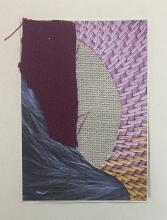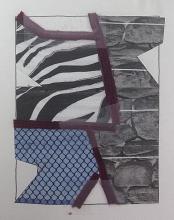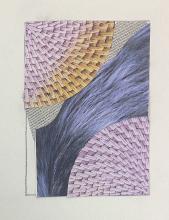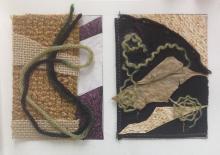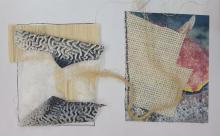Project Objectives
Develop visual understanding of the differences between subject matter and form.
Intentionally transform a representational design into an abstract or non-representational design to convey Content.
Develop visual understanding of the Element of Design Texture.
Project Description
In this project you continue to exercise ways to abstract from Subject Matter while focusing on Form by exploring Texture and evoke a sense of Touch creating visual interest in a design. Tactile texture is actual texture that can be felt with your hand; visual texture is the illusion of texture, a flat surface that appears to have a varied surface. Visual texture uses variation of line and repetition. For this project, we will explore how to use texture to create further interest in the designs we make.
Required Materials
Found Objects 9" x 12" Drawing Paper 14” x 17” Bristol Board Sketchbook HB Pencil Eraser Ruler PITT Pen Rubber Cement
Step-by-step Directions
Visual Presentation for Steps 1, 2 and 3 below:.
Step 1: Complete Exercise 2 | Texture Studies.
Step 2: In your sketchbook, using ruler and pencil, draw three 4" x 6" thumbnail frames.
Step 3: Create three (3) collage compositions (in the 4" x 6" thumbnails areas you just created in Step 2) using at least three (3) of the original found objects/textures you emulated in Exercise 3 | Texture Studies and creating at least five (5) different shapes out of the textures being used.
Note the Following:
Each composition should include at least three (3) different found textures.
Cut up the objects into at least five (5) interesting shapes; think about figure/ground relationships when creating these compositions.
Use convex/concave shapes and cut shapes into larger shapes.
Establish a Focal Point in one of the power points of the Rule of Thirds.
Establish Unity and Visual Flow by repeating the textures
You can overlap textures.
Fill out the whole field with the textures.
Glue down the textures in your sketchbook.
These compositions are collages made with the actual and implied textures you collected.
Step 4: Present or Text the three (3) 4" x 6" thumbnail Texture Collage compositions to Prof. Jacques.
Step 5: On 9” x 12” Drawing paper re-create the most successful composition using PITT pens, complete the composition. Use the various pen nib sizes (S, F, M, B) to create variation of line thickness and character.
Your drawing should take up the entire page.
Refer to your Exercise 2 | Texture emulations when re-creating each texture.
Step 6: Once your drawing is complete, mount it on the 14”x17” piece of Bristol board using your rubber cement glue. Make sure the drawing is centered; use your ruler to create guidelines with pencil before gluing.
Project Considerations
Is the composition non-representational?
Is the composition dynamic?
Are all areas of the picture plane activated?
Has a strong directional dominance been established?
Have I established a directional conflict?
Are there any implied lines in my composition?
Are there shapes created by the textures promoting interesting figure/ground relationships?
Are there at least 5 different value gradations creating full value range through the use of line systems?
Has the final design been executed in a professional manner? Designs should utilize the designated materials with care, effort, and attention to detail. This includes proper mounting to Bristol Board.
CRAFTSMANSHIP is extremely important for each of your designs and is part of the grading criteria. Do not fold, bend, crease, smudge, tear your artworks! Always take great care when creating each design and then put directly into your portfolio case.
What is Craftsmanship? Care in construction and finishing; demonstration of skill and knowledge of processes; attention to detail. The quality of design and work shown in something that is made by hand.
Project Delivery
In order to submit the Project, you nd to have submitted Exercise 2 | Texture Studies.
Created three texture collages with at least three textures and five shapes in the sketchbook.
Created final artwork.
Presented final drawing mounted on Bristol board.
Grading Criteria
This project is worth 9 points. | Each item is worth 1.5 points.
Project's Grade Rubric
Craftsmanship: Has the final design been executed in a professional manner?
Cut, Glued, Pasted properly and with Clean borders.
Materials: Does the design have at least three textures and five full value range elements? Is the design done in white 9” x 12” Drawing paper and mounted on Bristol board?
Elements of Design:
Does the design include positive/negative space, figure/ground relationships through refine use of mark making lines and textures? Are actual and implied textures clearly emulated?
Techniques: Does the design demonstrate an ability to use a variety of mark-making techniques to create variation of line and visual texture?
Principles of Organization:
Is Unity used so the elements of the design (lines, shapes, spaces, textures and values) are harmonious?
Is the design following an asymmetrical Balance, showing Movement through repetition as well as directional forces? Is emphasis clearly used to create a focal point?
Illusion of Depth: Does the design establish a full value range through the use of line and mark making (line proximity, compressed and expanded space) and establish a sense of space? Are vanishing points respected?
Exercise 2 | Texture is worth 3 points
Extra-credit Sketchbook is worth 0.5 point:
Presented/Texted thumbnail collages to Prof. Jacques. (0.5 point).

